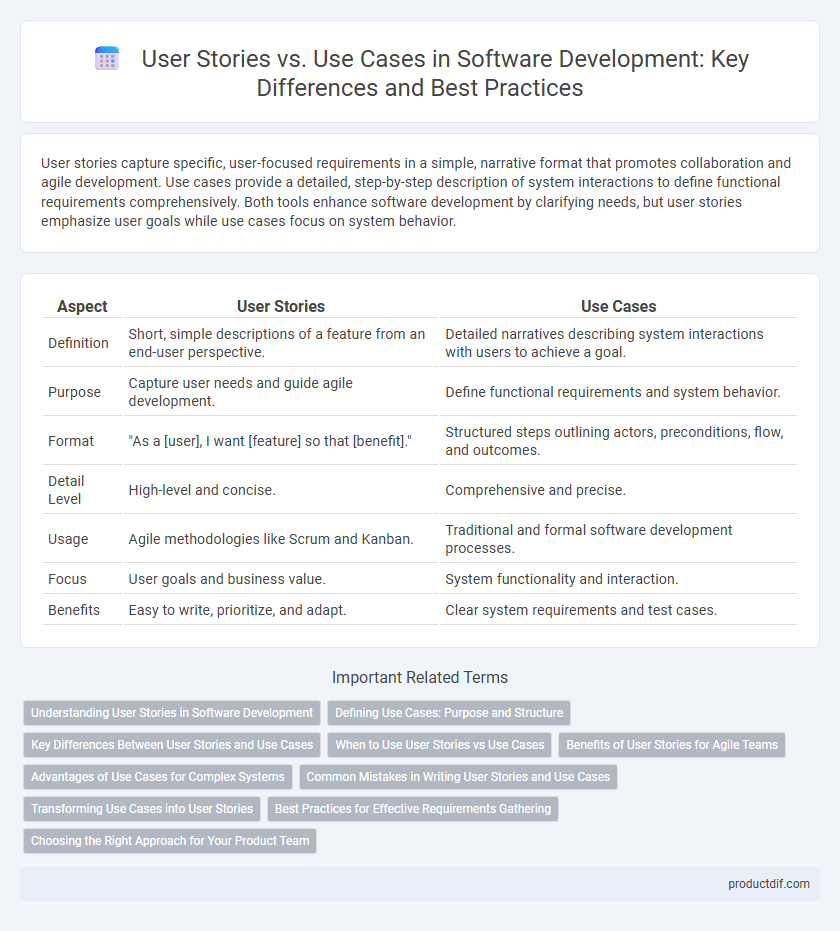User stories capture specific, user-focused requirements in a simple, narrative format that promotes collaboration and agile development. Use cases provide a detailed, step-by-step description of system interactions to define functional requirements comprehensively. Both tools enhance software development by clarifying needs, but user stories emphasize user goals while use cases focus on system behavior.
Table of Comparison
| Aspect | User Stories | Use Cases |
|---|---|---|
| Definition | Short, simple descriptions of a feature from an end-user perspective. | Detailed narratives describing system interactions with users to achieve a goal. |
| Purpose | Capture user needs and guide agile development. | Define functional requirements and system behavior. |
| Format | "As a [user], I want [feature] so that [benefit]." | Structured steps outlining actors, preconditions, flow, and outcomes. |
| Detail Level | High-level and concise. | Comprehensive and precise. |
| Usage | Agile methodologies like Scrum and Kanban. | Traditional and formal software development processes. |
| Focus | User goals and business value. | System functionality and interaction. |
| Benefits | Easy to write, prioritize, and adapt. | Clear system requirements and test cases. |
Understanding User Stories in Software Development
User stories in software development capture specific user needs through concise, natural language descriptions that focus on desired functionality from the end-user's perspective. They facilitate agile project management by promoting collaboration, iterative progress, and clear acceptance criteria for software features. Unlike detailed use cases, user stories emphasize simplicity and adaptability to drive development aligned with user value and business goals.
Defining Use Cases: Purpose and Structure
Use cases serve to capture system requirements by describing user interactions in a detailed scenario format, emphasizing goals and system responses to specific inputs. They include components such as actors, preconditions, triggers, main success scenarios, and alternative flows to ensure comprehensive coverage of functional requirements. Defining use cases helps bridge the gap between business needs and technical implementation by providing a structured narrative that guides developers and testers.
Key Differences Between User Stories and Use Cases
User stories are short, simple descriptions of a feature told from the perspective of the end user, focusing on user needs and goals. Use cases provide detailed, structured scenarios outlining interactions between users and the system, including preconditions and flow of events. Key differences include user stories being agile-friendly and lightweight, while use cases are more comprehensive and suited for detailed system design documentation.
When to Use User Stories vs Use Cases
User stories are best suited for agile development environments where quick iterations and continuous feedback drive requirement gathering, focusing on user needs and goals in simple, concise language. Use cases provide a more detailed, structured approach ideal for complex systems requiring comprehensive documentation and clear workflows, especially in traditional or large-scale projects. Choosing between user stories and use cases depends on project scope, stakeholder involvement, and the need for flexibility versus formal specification.
Benefits of User Stories for Agile Teams
User stories offer Agile teams a flexible and lightweight framework that enhances collaboration and prioritizes customer value. Their concise, narrative format promotes clear communication and quick iterations, enabling teams to adapt to changing requirements efficiently. This approach fosters continuous feedback and incremental delivery, driving better alignment with user needs and faster project outcomes.
Advantages of Use Cases for Complex Systems
Use cases provide clear, structured scenarios that capture system interactions, making them ideal for modeling complex software systems with multiple actors and intricate workflows. They facilitate better communication between stakeholders and developers by offering a comprehensive narrative of functional requirements and system behavior. Detailed use case documentation helps manage system complexity by breaking down functionality into manageable, goal-oriented tasks, improving traceability and validation throughout the software development lifecycle.
Common Mistakes in Writing User Stories and Use Cases
Common mistakes in writing user stories include vague acceptance criteria, lack of user persona specificity, and mixing technical details with user goals. Use cases often suffer from overly complex scenarios, failure to capture alternate flows, and unclear actor roles. Ensuring clarity, user-focused language, and comprehensive coverage of paths improves both documentation types significantly.
Transforming Use Cases into User Stories
Transforming use cases into user stories involves breaking down detailed scenarios into concise, user-focused tasks that emphasize user goals and benefits within agile frameworks. User stories prioritize clear acceptance criteria and iterative development, facilitating better communication between stakeholders and development teams. This approach streamlines requirements management by converting comprehensive use case narratives into actionable, testable user stories that drive incremental software delivery.
Best Practices for Effective Requirements Gathering
User Stories capture user needs in simple, concise language, enabling agile teams to prioritize features based on business value, while Use Cases provide detailed, structured interactions between users and systems, essential for complex requirements analysis. Best practices involve combining User Stories for flexibility and rapid iteration with Use Cases to ensure comprehensive system understanding and validation. Clear acceptance criteria, stakeholder collaboration, and iterative refinement enhance requirement accuracy and project success.
Choosing the Right Approach for Your Product Team
User stories offer agile-friendly, concise descriptions that prioritize user needs and facilitate iterative development, making them ideal for fast-paced product teams. Use cases provide comprehensive, detailed scenarios that capture system interactions and edge cases, supporting thorough requirements analysis and documentation. Selecting the right approach depends on your team's workflow, project complexity, and the need for flexibility versus depth in capturing functionality.
User Stories vs Use Cases Infographic

 productdif.com
productdif.com